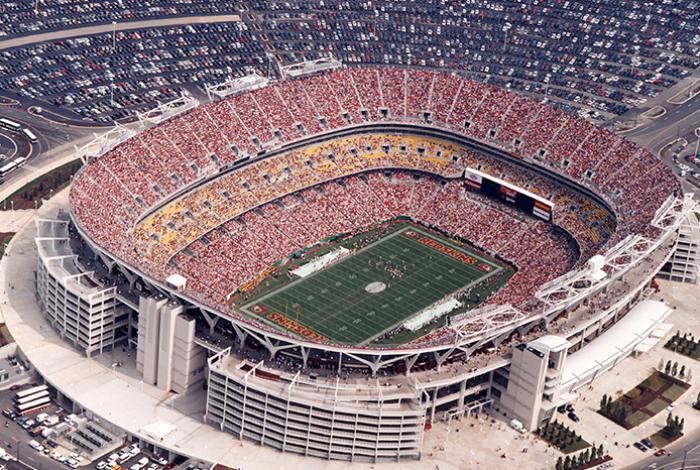As the year winds down, options for a new Washington Redskins stadium appear to be heating up, with two intriguing possibilities in play. However, both come with plenty of hurdles, serving as a reminder that the search may take considerable time to resolve.
Over the last few years, Redskins owner Daniel Snyder has been searching for an eventual replacement to FedEx Field. The club’s lease at the Landover, MD facility expires in 2027, and thus far two things are apparent: the team is showing no desire to remain at the FedEx Field site—regardless of whether it involves a renovation or building anew—and governments in the DC Metro area appear willing to engage with the team in new stadium discussions.
The leading contender for a new stadium in Washington, DC appears to be the RFK Stadium site. Home to the team from 1961-1996, the venerable RFK Stadium is expected to be demolished in the coming years, and one often discussed possibility for the site is a new NFL stadium anchoring a larger redevelopment.
Maryland, meanwhile, is emerging with a proposal to keep the team in the state. Under a tentative agreement recently announced by governor Larry Hogan, the state and federal government would agree to a land swap that leads to Maryland taking over 300 acres at Oxon Cove Park in exchange for yet-to-be-disclosed land in Western Maryland. The state would then use the Oxon Cove Park land for a stadium project, with the venue surrounded by new development.
Both plans carry their own intrigue. The sentimental angle of the Redskins returning to the RFK Stadium site would be a notable one, but the site also offers plenty of advantages for a modern NFL venue—including easy access and room for surrounding amenities. An Oxon Cove stadium would be close to DC and Virginia, while being located near amenities such as MGM National Harbor Casino.
Yet, neither plan is a slam dunk at this stage. Any future development of the RFK Stadium site would involve a series of considerable hurdles, as Events DC manages the RFK Stadium site under a lease with the National Park Service that expires in 2038. A lease extension will be needed to make any new stadium plan viable, and local and federal officials would have to determine whether to change language in the existing lease that effectively bans any commercial development site. Congressional Republicans recently floated a plan that would do that while extending the lease for the site, but its passage is not at all certain at this stage. The balance of power in congress is also in a state of transition, with Democrats set to take over the House of Representatives early next year.
The new stadium concept out of Maryland also has its own hurdles. The land swap is not finalized at this point, but there have been concerns from various lawmakers since the deal was announced, as well as criticisms from some environmental groups and nearby residents. Parts of the plan would require approval from both the state’s General Assembly and U.S. Congress.
Hogan has said that state taxpayer money will not go toward the stadium itself, though the fact that he has left the door open for funding infrastructure improvements is a point of contention for some lawmakers. Additionally, Oxon Cove is not served by Metro, leaving at least one major question about access options.
Another point of contention that could surface is the polarizing Redskins name. Though some officials key to a new stadium—including Hogan and Washington D.C. mayor Muriel Bowser—are not making a name change a contingency for their support, the name is criticized in many circles as a stereotype offensive to Native Americans. It is hard to tell at this stage whether opposition to the name becomes a factor in new stadium discussions, but Snyder has refused in the past to make a change.
For their part, the Redskins have not committed to a site and have not released many particulars on what they want in a new stadium plan. Without that, the cost estimate and financing will remain unknowns, and decisions will also have to be made on the scope of any mixed-use development surrounding a stadium.
Given the number of uncertainties involved, it will take time for a new Redskins stadium in Washington, Maryland or Virginia—which could remain an option, despite little public discussion in recent months—to come together. That is perhaps why the team is already looking ahead, as weighing options for a new Redskins stadium requires consideration of intriguing sites that will not offer a swift resolution.
This article first appeared in the weekly Football Stadium Digest newsletter. Are you a subscriber? It’s free, and you’ll see features like this before they appear on the Web. Go here to subscribe to the Football Stadium Digest newsletter.

